What to do with horrific images from Iraq
PARIS, June 18, 2014 - Deeply disturbing images show Islamic State of Iraq and the Levant (ISIL) militants executing soldiers or security force members somewhere in Iraq’s Salaheddin province. They were first uploaded on June 14 and soon appeared on various websites and jihadist Twitter accounts, and they have now been published by AFP and other news agencies.
Pictures like these clearly amount to extremist propaganda, so should they have been published? For AFP, the answer is yes -- but not without first taking careful precautions to ensure they were not faked. We also avoided publishing those photos depicting gratuitous violence for its own sake.
At AFP’s Middle East headquarters, located in Nicosia, a team of Arabic-speaking journalists constantly monitor radical Islamist websites and social network accounts, looking for news and images coming out of war zones in Iraq and Syria.
“You have to be quick,” says Patrick Baz, photo manager for the Middle East and North Africa. “The links can disappear from one minute to the next. And often Twitter will delete accounts with violent content.”

These images of mass executions were first made public by the jihadist site Welayat Salahuddin, then spread quickly on Twitter. For AFP, it was clear we had to transmit the images.
We ran these pictures because of their historical importance, attesting to the extreme harshness of the current situation in Iraq. Also, because Agence France-Presse does not typically deliver content directly to consumers (apart from this blog), it sends pictures to client media outlets who then decide whether to publish pictures, according to their own editorial guidelines and practices.
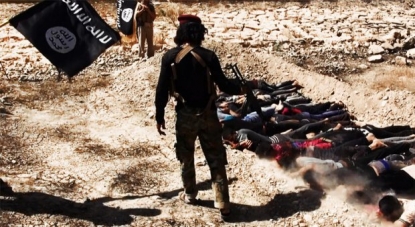
(AFP / HO / Welayat Salahuddin)
“You have to show what happened,” says Baz. “At the moment, no journalist or independent observer can get into jihadist-held areas without facing imminent kidnapping or death. These pictures are the only evidence available. Of course, it’s propaganda. These photos are designed to terrorise the enemy. But these are also pictures of historic value, just like those images of Nazi officers executing resistance fighters and Jews.”
AFP does not use images of violence with dubious or non-existent news value. Accordingly, we didn’t publish a close-up shot of a man who had been repeatedly kicked in the head, or another picture of a militant holding a decapitated head. Broadly speaking, other agencies have the same criteria.
We also needed to be certain that the images hadn’t been faked. One of the questions that arose with the first picture of the executions was whether extra bodies had been added into the picture by with Photoshop or some such image-manipulation software, to try to make the photo even more impactful. This old propaganda trick has been used by North Korea to try to dupe the international media. AFP uses forensic software called Tungstene to look for whether a picture has been altered.
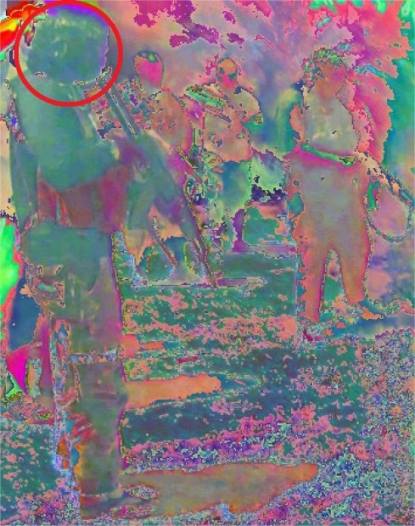 The image at the top of the page as analysed by the Tungstene retouch-detection software. An examination shows clearly (in the red circle) that one man's face has been manipulated to make him unrecognisable. (AFP)
The image at the top of the page as analysed by the Tungstene retouch-detection software. An examination shows clearly (in the red circle) that one man's face has been manipulated to make him unrecognisable. (AFP)It can be complicated to operate – revealing an alteration made by an expert can take a whole day – but Tungstene in this case showed that the photos of the ISIL in Iraq had not been significantly manipulated.
“The examination showed a few retouches,” says Antonin Thuillier, AFP’s Tungstene specialist. “The colours have been over-saturated, perhaps to better highlight the pools of blood. The jihadists’ faces have been darkened (see red circle, above). Finally there’s some doubt around the smoke in the background. The red spots, in the image below, show two areas of the photo that are identical. The Photoshop clone tool could have been used to hide something behind, or perhaps even some dust on the camera sensor.”
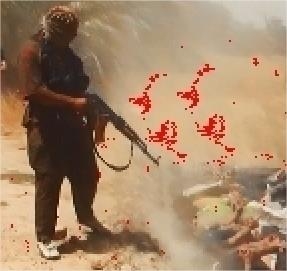 Tungstène also reveals that a part of the image has probably been altered with the Photoshop cloning tool to hide something in the background or to remove some dust on the camera sensor. (AFP)
Tungstène also reveals that a part of the image has probably been altered with the Photoshop cloning tool to hide something in the background or to remove some dust on the camera sensor. (AFP)The task is complicated by the fact that this type of photo circulates widely online before it is picked up by journalists. Every user or web site could change the image in a myriad of ways, such as adding watermarked logos or commentaries before republishing the picture. “When I find an interesting picture, I try to go back to the original,” says Baz. “And if I can’t do that, I reframe the image to remove the elements without news value.”
Originally, the photo published online looked like the one below. The first Arabic phrase says it is an “Assad al-Rahman al Bilawi alias Abu Abd al-Rahman” operation, the name of a jihadist leader killed by Iraqi forces in Fallujah. The second phrase gives more details: “The liquidation of members of the Safavid army who were fleeing in civilian clothes.” (The Safavid dynasty ruled Iran for hundreds of years and converted to Shiite Islam and converted many populations during their conquests. “Safavids” is the nickname given to Shiites by extremist Sunnis.)
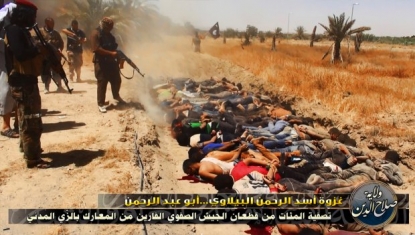 The image as it was disseminated by the jihadists online, before reframing. (AFP / HO / Welayat Salahuddin)
The image as it was disseminated by the jihadists online, before reframing. (AFP / HO / Welayat Salahuddin)In the case of the photo at the top of this page, “the manipulations don’t seem to have been done to significantly alter the photo’s informational content,” says Thuillier. There are no extra bodies or militants added by Photoshop. AFP therefore published the photo, along with a warning alerting clients to possible retouches and adding clearly that this was a photo pulled from the Internet, making it impossible to independently verify the date and location of the image.
“Of course, Tungstene can’t detect photos that have been wholly staged,” adds Thuillier. “If the jihadists had decided to pile bodies here from another location, or even if people are lying on the floor and pretending to be dead to make the scene more terrifying, the software can’t detect that.”
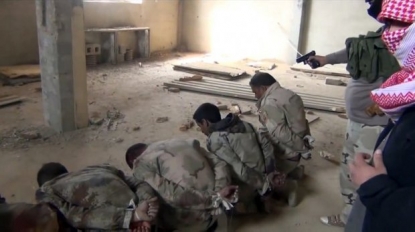 This image, pulled from a video on YouTube in February 2014, purportedly shows ISIL militants executing a group of Iraqi soldiers somewhere in Anbar province. (AFP / HO / YouTube)
This image, pulled from a video on YouTube in February 2014, purportedly shows ISIL militants executing a group of Iraqi soldiers somewhere in Anbar province. (AFP / HO / YouTube)But the likelihood of this being staged is low, says Baz. Considering the type of violence known to have been perpetrated by ISIL over recent months in Iraq and Syria, it seems more likely that this was a real event.
“The jihadists don’t need to stage incidents,” says the photographer, who has covered conflicts in the Middle East and elsewhere for nearly 30 years.


